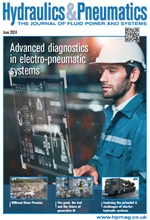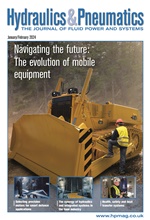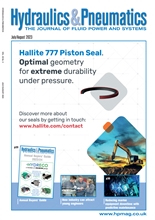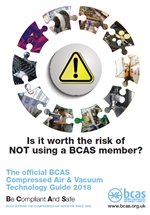Modern hose applications demand reliability, sustainability, performance and prevention (May 2013)
By Pierluigi Pelanda & Fabio Meriggi, Parker Hannifin.
Designers of hydraulic machinery are increasingly defining new products that require hydraulic circuits with tighter curves, higher pressures and less space in which to route flexible connections and achieve a solution. Also, such equipment which is used in a wide and diverse range of applications including construction machinery, mining equipment and marine units, is used in increasingly tough operating environments where ambient conditions are extreme; for example low temperatures and high humidity.
The option to use flexible connections that are tested over and above the generally accepted norms and specifications and, that offer reliability and performance to the highest market standards, give peace of mind and the possibility to enhance the reputation and dependability of products developed by engineering and design departments.
Picking a trusted source for a safety and reputation critical component
To meet hydraulic application demands for reliability and performance, engineers typically look at medium pressure braided hose ranges with a compact design and no-skive fittings. They often tend towards well known and established names on the market, where real-world long life and dependability have been proven.
Specifications and approvals, of course underpin the ultimate choice for the type of hydraulic flexible connection chosen and mounted on the machine application. Hoses and fittings need to be tested against the requirements of the major internationally accepted standards such as EN, SAE and ISO. Approvals by external bodies such as Det Norske Veritas, Lloyd’s Register, – Germanischer Lloyd, American Bureau of Shipping, Bureau Veritas, and Registro Italiano Navale add more value and confidence for engineers working on key, often high profile projects.
Designing in reliability
One of the most important factors engineers look for is reliability. In the case of a hydraulic hose line that primarily means the integrity of its connection. Hoses that use no-skive technology, such as the Elite range from Parker, are the preferred choice. Skiving is the removal or shaving of part of the hose cover and / or inner prior to attaching the hose ends. No-skive promotes reliability and longevity as the hose core is not exposed to potential damage when the end fittings are crimped in place. Effective no-skive technology also speeds up hose assembly, alleviates the need for additional clean-up steps, and improves repeatability from hose to hose.
Meticulous design, testing and manufacturing processes for hoses and fittings will help ensure an excellent mechanical connection between the hose and the fitting. A completely leak-free connection gives long service life even with continuous use at very high pressures. Using a single source for the hose preparation and assembly gives cost and time savings to the assembler and helps assure a defect-free, reliable and durable final product for the end-user. This approach is the best way to meet the requirements of SAE J1273 and ISO 17165-2 which pay particular attention to matching the hose with the fittings.
The growing importance of sustainability
In addition to reliability another very important aspect of hydraulic hose design is – sustainability. Sustainability means meeting the current needs of applications whilst preserving natural resources, minimising the impact on society and enabling future generations to meet their needs.
Sustainability is a strategy that underlines and ‘wraps around’ many initiatives, integrating life cycle assessment into the product development process for leading, responsible manufacturers. Transparency in the use of chemicals, processes and materials and utilising technical know-how and engineering skills are key to meeting this increasingly important and globally relevant requirement.
There are three factors in the industrial market driving sustainability as a platform capability; they are scarcity of natural resources; risk reduction, and regulation.
An example of a hydraulic hose product range that has been developed with sustainability as a driving principle is the Compact Spiral hose range from Parker. Due to the reduced use of materials needed to manufacture Compact Spiral hoses and thanks to the fact that, due to its high degree of flex, it requires less hose to connect different ports, this hose range provides a good reference point for sustainable design. By reducing the weight of spiral hose used on a machine, a positive outcome can be achieved as weight reductions lead directly to full consumption savings.
More recently, the introduction by Parker of chlorine free hose ranges, with follows the philosophy of having the lowest possible environmental impact and to reducing the risk and impact the products present to the environment at end of life. New compounds are also being developed by hose manufacturers in order to meet the stringent requirements of the REACH and RoHS European regulations.
Of course the use of hose materials with maximum sustainability and a minimal impact on the environment at end of life need to be complemented by hose fittings with similar credentials. Together with its Elite range, Parker Hannifin offers a full range of fittings that are both lead and Cr6 (the element chromium in the +6 oxidation state) free, while still delivering a high degree of corrosion resistance in line with market expectations.
Applications become more challenging
Particularly challenging are applications in earth-moving and construction machinery that require higher performance from the hoses they use in terms of flexibility, a tight bending radius and resistance to very low temperatures.
Hoses that answer such needs and deliver the highest performance are the obvious choice for engineers working on behalf of equipment manufacturers offering them the possibility to design more aggressive angles for the moving parts on their machines. The Elite low temperature range from Parker, for example, can be used in applications with an ambient temperature of down to -50degC.
In certain applications, higher pressures, even stretching to 350 bar, are required whilst still needing a hose that gives flexibility, has low weight, minimal dimensions and a tight bending radius. The same needs also apply to spiral hoses, which are required for hydraulic applications with dynamic working pressures as high as 500 bar.
Minimised unexpected downtime equals minimised cost and inconvenience
High performance most often goes hand-in-hand with long life and reliability which translates into reduced machine downtime caused by hose assembly failure. However, through a preventive maintenance programme, unexpected, unscheduled and costly downtime can be largely avoided.
A Preventive Maintenance Programme may comprise regular checks of the hydraulic circuit and of all the flexible parts that compose it. Further action, to replace elements of, the full assembly are undertaken if certain issues are detected or observed during the planned programme. These may include:
· Damaged, cracked, cut or abraded covers.
· Exposed reinforcement.
· Cracked, damaged or corroded fittings.
· Leaks in fittings, sweating hose cover close to fitting.
· Kinked, crushed, flattened or twisted hose.
· Hard, stiff, cracked or burnt hose.
· Blistered, soft, degraded or loose covers.
· Fitting slippage on the hose.
In the market, some suppliers offer an added value service that enhances and speeds hose replacement. This includes a hose assembly documentation and replacement programme, tags that contain custom data or replacement options that users can personalise, unique identification numbers for every hose, and barcodes to speed product identification. Through such comprehensive information a manufacturer can follow the life of each hose assembly, and know how many times it has been changed and why.
Identification systems such as the Parker Tracking System (PTS) are designed to help customers reduce vehicle or asset downtime through increases in the speed, timing and accuracy of necessary repairs. Using a Web-based application, PTS generates a unique identification code for each hose assembly which is printed on a durable barcode. Identifiers such as Parker’s PTS labels are specifically engineered to withstand harsh chemicals, temperatures, UV exposure and other challenging conditions that are typical of many of the latest applications.
Photo caption: Parker Hannifin’s Elite range of wire braided hydraulic hoses exceeds European regulations for abrasion resistance and pressure ratings.
Events
-
Smart Manufacturing & Engineering Week
05 - 06 June, 2024
NEC, Birmingham -
HILLHEAD 2024
25 June, 2024, 9:00 - 27 June, 2024, 16:00
Hillhead Quarry, Buxton, Derbyshire UK










